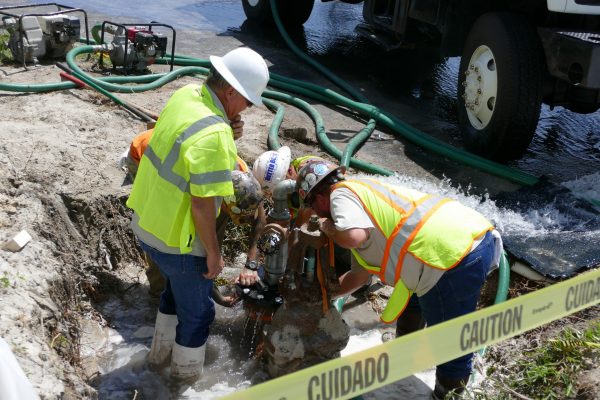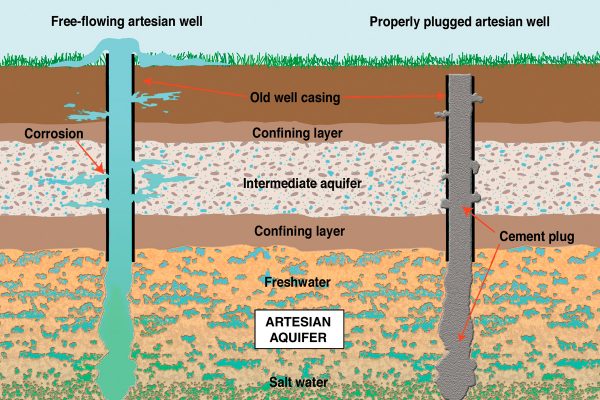Free-flowing abandoned artesian wells can potentially waste millions of gallons of water each day. Uncontrolled, improperly constructed or deteriorating artesian wells can have an adverse impact on the quantity and quality of water within aquifers and other water bodies. In addition, non-flowing abandoned wells may also act as a conduit for sources of contaminants to enter the aquifer from the land’s surface.
The goal of the St. Johns River Water Management District’s Abandoned Artesian Well Plugging Program is to assure the continued availability and quality of groundwater resources by detecting, evaluating and controlling free-flowing artesian wells.
Florida law requires well owners to control the discharge from artesian wells, limiting the flow to only the amount of water needed for an intended use. The Florida Legislature enacted regulations requiring well owners to control the flow of artesian wells by installing valves or other flow-control devices. Wells that cannot be controlled due to deterioration of the valves or casing must be permanently plugged. The well plugging program also supports the District’s core missions of water supply and water quality.
The District’s Abandoned Artesian Well Plugging Program is designed to assist well owners in complying with state law in properly plugging artesian wells so they no longer allow water to flow to the surface or between aquifer layers. Assistance is offered through cost-share programs, technical guidance and oversight of licensed well contractors while the well is being permanently plugged.
Since the early 1980s, the District has aggressively worked with other agencies, local governments and the public to detect, evaluate and control abandoned artesian wells.
An artesian well is a well that has been drilled into an aquifer in a location where the underground pressure is great enough for the water to rise inside the well. In some cases, the water is under enough pressure to rise from the aquifer to the land’s surface without need of a pump. These artesian wells are known as free-flowing wells.
In addition to wasting water resources, old free-flowing wells typically are in a deeper portion of the aquifer that may be susceptible to an increase in salinity at some locations. As a well ages, deterioration of the well casing occurs, which can allow poor quality water to move upward into fresher zones used for drinking water supplies. Proper plugging of these wells helps to prevent contamination of our groundwater supply.
Plugging a well involves a site visit and well inventory, correspondence with the landowner and governments to formalize participation, geophysical logging of the well and permanent well plugging by a licensed well contractor.
Abandoned wells are plugged by pumping cement (grout) through a PVC pipe or drill rod, which is lowered to the bottom of a well. The cement is pumped into the well until it flows back to the land’s surface.
Costs to plug a well can vary depending on the size and depth of the well and the plugging method required, but it generally costs (districtwide) several thousand dollars to properly plug each well.
For additional information on the program, cost-share for abandoning a well, or to notify the District of a free-flowing well, please contact:
386-643-1152
Fast facts
- Since 1982, the District has plugged or capped 2,725 wells with a maximum potential water savings of 745 million gallons per day.
- Plugging a free-flowing well is free within the District’s 18-county jurisdiction.
- A $600 fee charged prior to Nov. 9, 2021, for residential properties and a 50/50 match for agricultural, commercial and industrial free-flowing wells have been waived by the District’s Governing Board.
- Members of the public who wish to participate in the District program to have their well abandoned at no cost to them will work only with the District and its contractors. Homeowners are welcome to work with any qualified well contractor to have a well plugged, however they will be solely responsible for the cost of abandoning the well when they do not work through the District’s program.
- The District has cost-share agreements with Brevard, Indian River and Seminole counties for the well plugging program.
- With more than 7 million acres of publicly and privately owned land within the District’s boundaries, finding abandoned wells is the biggest challenge. The District relies on private property owners to identify wells and to work cooperatively with the District to permanently halt the waste of water.



